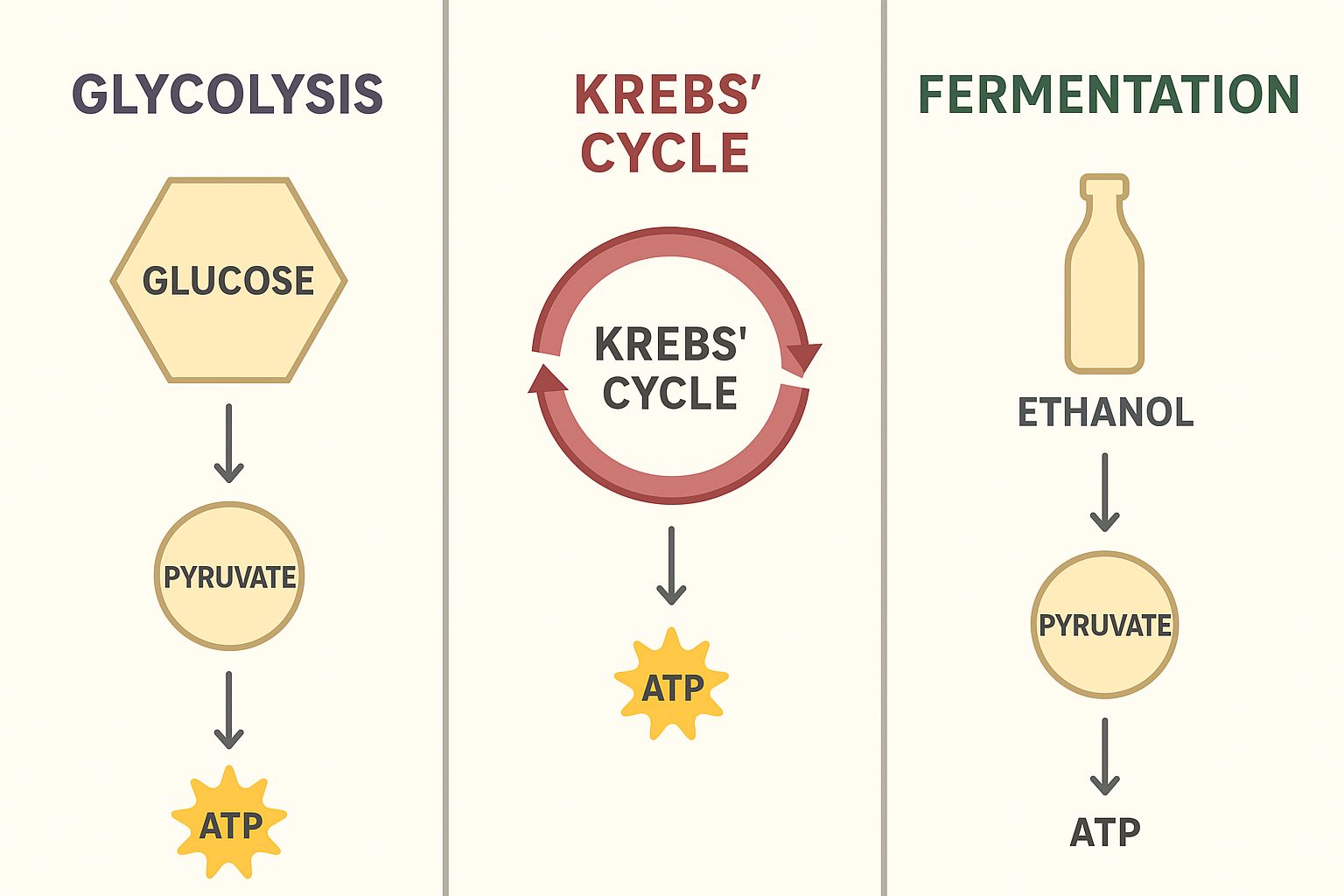1st PUC Biology Question and Answer: RESPIRATION IN PLANTS
Looking for 1st PUC Biology textbook answers? You can download Chapter 14: RESPIRATION IN PLANTS Questions and Answers PDF, Notes, and Summary here. 1st PUC Biology solutions follow the Karnataka State Board Syllabus, making it easier for students to revise and score higher in exams.
Karnataka 1st PUC Biology Textbook Answers—Reflections Chapter 14
RESPIRATION IN PLANTS Questions and Answers, Notes, and Summary
1st PUC Biology Chapter 14
RESPIRATION IN PLANTS
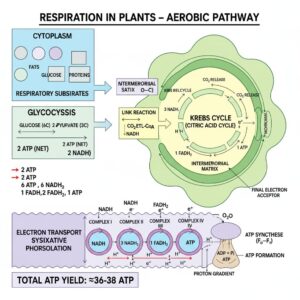
Scroll Down to Download RESPIRATION IN PLANTS PDF
Question and Answer:
Question 1.
Differentiate between
(a) Respiration and Combustion
(b) Glycolysis and Krebs’ cycle
(c) Aerobic respiration and Fermentation
Answer:
(a) Respiration vs Combustion
Feature | Respiration | Combustion |
Definition | A biological process in which organic molecules (like glucose) are broken down enzymatically to release energy. | A chemical process where a substance reacts rapidly with oxygen to release energy as heat and light. |
Control | Enzyme-catalysed, regulated by cellular machinery. | Not enzyme-catalysed, uncontrolled reaction. |
Rate of Reaction | Slow and stepwise to capture energy in ATP. | Fast and explosive. |
Energy Released | Partly stored in ATP for cellular activities; some released as heat. | Almost all energy released as heat and light. |
Products | CO₂, H₂O, and ATP (in aerobic respiration) | CO₂, H₂O, and heat/light (in complete combustion) |
Occurrence | Occurs in all living cells. | Occurs in non-living and living systems (if exposed to fire). |
(b) Glycolysis vs Krebs’ Cycle (TCA Cycle)
Feature | Glycolysis | Krebs’ Cycle |
Location | Cytoplasm of the cell | Mitochondrial matrix |
Oxygen Requirement | Can occur in presence or absence of oxygen (anaerobic) | Requires oxygen indirectly (aerobic respiration) |
Substrate | Glucose (6C) | Acetyl-CoA (2C) |
End Product | 2 Pyruvate, 2 ATP (net), 2 NADH | 3 CO₂, 1 ATP (GTP), 4 NADH, 1 FADH₂ per acetyl-CoA |
Energy Yield | Small amount of ATP (net 2) | Higher energy yield; contributes electrons to ETS for more ATP |
Function | Initial breakdown of glucose | Complete oxidation of pyruvate-derived acetyl-CoA |
(c) Aerobic Respiration vs Fermentation
Feature | Aerobic Respiration | Fermentation |
Oxygen Requirement | Requires oxygen | Occurs without oxygen (anaerobic) |
Location | Cytoplasm (glycolysis) + Mitochondria (Krebs & ETS) | Cytoplasm only |
End Products | CO₂ + H₂O + ATP | Lactic acid (animals) or Ethanol + CO₂ (yeast) |
ATP Yield | High (~36–38 ATP per glucose) | Low (2 ATP per glucose) |
Electron Acceptor | Oxygen (final electron acceptor) | Organic molecule (pyruvate or acetaldehyde) |
Energy Efficiency | Efficient, maximum energy extraction | Inefficient, only partial energy extracted |
Question 2.
What are respiratory substrates? Name the most common respiratory substrate.
Answer:
Respiratory substrates are the compounds that are oxidized during respiration to release energy in the form of ATP. They provide the necessary fuel for cellular activities.
- The most common respiratory substrate is carbohydrates, especially glucose.
- Other compounds like proteins, fats, and organic acids can also serve as respiratory substrates in some plants under certain conditions.
Question 3.
Give the schematic representation of glycolysis?
Answer:
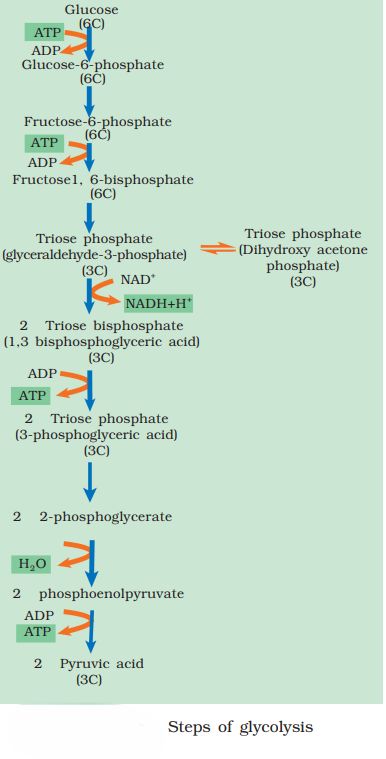
Question 4.
What are the main steps in aerobic respiration? Where does it take place?
Answer:
The major steps of aerobic respiration and their sites of occurrence are as follows:
Step | Site of Occurrence |
Glycolysis | Cytoplasm |
Krebs cycle | Matrix of mitochondria |
Electron transport system (ETS) | Inner mitochondrial membrane |
Oxidative phosphorylation | F₀–F₁ particles of inner mitochondrial membrane |
Question 5.
Give the schematic representation of an overall view of Krebs’ cycle.
Answer:
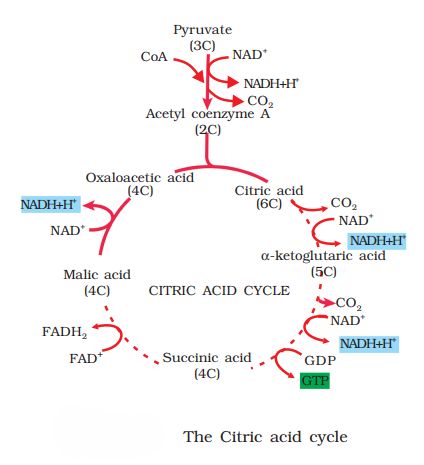
Question 6.
Explain ETS.
Answer:
Electron Transport System (ETS):
- ETS occurs in the electron transport particles (ETP) on the inner surface of the inner mitochondrial membrane.
- It is a metabolic pathway in which electrons are passed from one carrier to another, ultimately producing ATP.
Process:
- Electron Transfer:
- Electrons from NADH (produced in the mitochondrial matrix during the Krebs cycle) are oxidized by NADH dehydrogenase (Complex I).
- Electrons are then transferred to ubiquinone (coenzyme Q).
- FADH₂ (from succinate oxidation by succinate dehydrogenase, Complex II) also transfers electrons to ubiquinone.
- Reduced ubiquinone (ubiquinol) passes electrons to cytochrome bc₁ complex (Complex III).
- Cytochrome c acts as a mobile carrier between Complex III and Complex IV (cytochrome c oxidase complex), which contains cytochromes a and a₃ and two copper centers.
- ATP Formation (Oxidative Phosphorylation):
- Electron transfer through Complexes I–IV pumps protons (H⁺) from the matrix to the intermembrane space, creating a proton gradient.
- Protons flow back into the matrix via ATP synthase (Complex V), which consists of:
- F₁: Peripheral headpiece with ATP synthesis site
- F₀: Integral membrane channel for protons
- The energy of the proton gradient drives the formation of ATP from ADP and inorganic phosphate (iP).
- Role of Oxygen:
- Oxygen is the terminal electron acceptor, combining with electrons and hydrogen to form water, keeping the system moving.
Energy Yield:
- Oxidation of 1 NADH → 3 ATP
- Oxidation of 1 FADH₂ → 2 ATP
Summary:
ETS couples the transfer of electrons to ATP production via oxidative phosphorylation, making it the major source of energy in aerobic respiration.
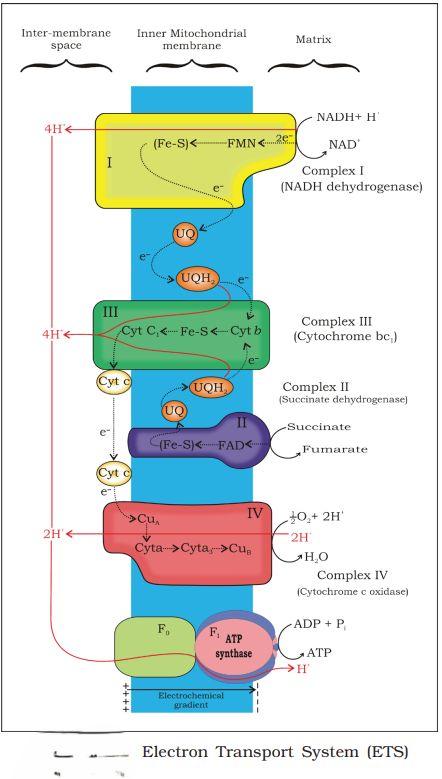
Question 7.
Distinguish between the following:
(a) Aerobic respiration and Anaerobic respiration
(b) Glycolysis and Fermentation
(c) Glycolysis and Citric acid Cycle
Answer:
(a) Aerobic respiration and Anaerobic respiration
Feature | Aerobic Respiration | Anaerobic Respiration |
Oxygen requirement | Takes place in the presence of oxygen | Occurs in the absence of oxygen |
End products | CO₂ and H₂O | Ethanol and CO₂ (in yeast) or lactic acid (in muscles) |
ATP yield | High (36–38 ATP per glucose) | Low (2 ATP per glucose) |
Site of occurrence | Cytoplasm and mitochondria | Cytoplasm only |
Completeness of oxidation | Glucose completely oxidized | Glucose partially oxidized |
(b) Glycolysis and Fermentation
Feature | Glycolysis | Fermentation |
Definition | Breakdown of glucose (6C) to two molecules of pyruvate (3C) | Conversion of pyruvate into alcohol or lactic acid |
Oxygen requirement | Can occur with or without oxygen | Always occurs without oxygen |
Site of occurrence | Cytoplasm | Cytoplasm |
End products | 2 Pyruvate, 2 ATP, 2 NADH | Ethanol + CO₂ or lactic acid + NAD⁺ |
Role in respiration | Common step in both aerobic and anaerobic respiration | Alternative pathway after glycolysis under anaerobic conditions |
(c) Glycolysis and Citric Acid Cycle (Krebs Cycle)
Feature | Glycolysis | Citric Acid Cycle (Krebs Cycle) |
Site of occurrence | Cytoplasm | Mitochondrial matrix |
Starting molecule | Glucose (6C) | Acetyl-CoA (2C) |
End products | 2 Pyruvate, 2 ATP, 2 NADH | CO₂, NADH, FADH₂, and ATP |
Oxygen requirement | Does not require oxygen directly | Requires oxygen indirectly (aerobic process) |
Type of process | Anaerobic process | Aerobic process |
ATP yield | 2 ATP (net gain) | 1 ATP per cycle (2 per glucose) |
Question 8.
What are the assumptions made during the calculation of net gain of ATP?
Answer:
The calculation of net gain of ATP for every glucose molecule oxidised is based on the following assumptions:
- There is a sequential and orderly pathway functioning, where one substrate forms the next, and glycolysis, TCA cycle, and ETS operate one after another without any deviation.
- The NADH synthesized during glycolysis in the cytoplasm is transported into the mitochondria and undergoes oxidative phosphorylation to produce ATP.
- The respiratory pathway operates efficiently, with no intermediate compounds being used for other biosynthetic purposes.
- Complete oxidation of one molecule of glucose takes place under aerobic conditions.
Note:
In actual conditions, the net gain of ATP may be slightly less than the theoretical 38 ATP, due to energy loss during transport of NADH into mitochondria and other cellular activities.
Question 9.
Discuss “The respiratory pathway is an amphibolic pathway.”
Answer:
Glucose is the most favoured substrate for respiration, and all other carbohydrates are usually first converted into glucose before being used in respiration.
Respiration involves both the breakdown (catabolism) and the synthesis (anabolism) of substrates; hence, it performs dual functions.
- Catabolic role:
During respiration, glucose is broken down to release energy. This degradative process is called catabolism. - Anabolic role:
Many intermediates of the respiratory pathway are withdrawn and used for the synthesis of new compounds. For example, acetyl-CoA can be used to synthesize fatty acids when required. This constructive process is called anabolism.
Thus, since the respiratory pathway involves both catabolic and anabolic activities, it is known as an amphibolic pathway.
Question 10.
Define RQ. What is its value for fats?
Answer:
Respiratory Quotient (RQ):
Respiratory Quotient or Respiratory Ratio is defined as the ratio of the volume of carbon dioxide (CO₂) liberated to the volume of oxygen (O₂) consumed during respiration.
The value of the respiratory quotient depends on the type of respiratory substrate used:
- For carbohydrates, the RQ is 1.
- For fats, the RQ is less than 1 because fats require more oxygen for complete oxidation than the amount of CO₂
Hence, the RQ value for fats is approximately 0.7.
Question 11.
What is oxidative phosphorylation?
Answer:
Oxidative phosphorylation is a metabolic pathway in which ATP is synthesized using the energy released during the oxidation of nutrients.
- Electrons are transferred from electron donors (NADH and FADH₂) to electron acceptors such as oxygen through a series of redox reactions in the electron transport chain (Complexes I–IV) located in the inner mitochondrial membrane.
- The energy released during electron transfer is used to pump protons (H⁺) across the membrane, creating a proton gradient.
- Protons flow back into the matrix via ATP synthase (Complex V), driving the production of ATP from ADP and inorganic phosphate (Pi).
- ATP yield: Oxidation of 1 NADH → 3 ATP; oxidation of 1 FADH₂ → 2 ATP.
- Oxygen acts as the final electron acceptor, combining with electrons and protons to form water.
Unlike photophosphorylation, where light energy generates the proton gradient, in oxidative phosphorylation, it is the energy from oxidation-reduction reactions that drives ATP synthesis, hence the name.
Site: Inner mitochondrial membrane
Question 12.
What is the significance of step-wise release of energy in respiration?
Answer:
Respiration is the process by which energy is released from food molecules (respiratory substrates) such as carbohydrates, fats, and proteins through oxidation.
Significance of step-wise energy release:
- Controlled energy release:
- Energy in food is not released all at once; it is released gradually in a series of enzyme-controlled steps.
- Efficient ATP production:
- The energy released in small steps is trapped in the form of ATP, which acts as the energy currency of the cell.
- Safety for the cell:
- Sudden release of all energy at once would be wasted as heat and could damage cellular components.
- Support for biosynthesis:
- Carbon skeletons and intermediates produced during respiration can be used as precursors for the synthesis of other molecules in the cell.
- Energy availability on demand:
- ATP can be broken down wherever and whenever energy is needed for various cellular processes, making energy use efficient and controlled.
Conclusion:
Step-wise release of energy ensures safe, efficient, and regulated energy production, while simultaneously providing intermediates for biosynthesis.
Additional Questions and Answers
Question 1.
What are respiratory substrates? Name the most common one.
Answer:
Respiratory substrates are organic compounds that are oxidized to release energy during respiration.
- Most common respiratory substrate: Glucose
- Other substrates: Fats, proteins, and organic acids.
Question 2.
Give the schematic representation of glycolysis.
Answer:
Glycolysis (in cytoplasm):
Glucose (6C) → Glucose-6-phosphate → Fructose-6-phosphate → Fructose-1,6-bisphosphate → Glyceraldehyde-3-phosphate → 2 Pyruvate (3C each)
- Net ATP: 2
- NADH formed: 2
Question 3.
Differentiate between:
Answer:
(a) Respiration and Combustion
Feature | Respiration | Combustion |
Control | Enzyme-controlled | Uncontrolled |
Energy release | Gradual, trapped as ATP | Sudden, lost as heat |
By-products | CO₂ + H₂O | CO₂ + H₂O |
(b) Aerobic respiration and Fermentation
Feature | Aerobic | Fermentation |
Oxygen | Required | Not required |
ATP yield | 36–38 | 2 |
End products | CO₂ + H₂O | Alcohol + CO₂ / Lactic acid |
Question 4.
Name the end products of:
Answer:
- Aerobic respiration: CO₂ and H₂O
- Anaerobic respiration in yeast: Ethanol + CO₂
- Anaerobic respiration in muscles: Lactic acid
Question 5.
Why is oxygen called the final electron acceptor?
Answer:
In aerobic respiration, electrons are transferred through the electron transport chain to oxygen, which combines with protons to form water. Without oxygen, electrons cannot flow, and ATP production stops.
Question 6.
What is the net ATP yield from one glucose molecule?
Answer:
- Glycolysis: 2 ATP
- Krebs cycle: 2 ATP
- Electron Transport Chain (oxidative phosphorylation): 34 ATP
Total: 36–38 ATP per glucose molecule
Question 7.
Explain the term “oxidative phosphorylation.”
Answer:
ATP synthesis that occurs when energy released from electron transfer in the ETS is used to phosphorylate ADP to ATP. Oxygen acts as the final electron acceptor.
Question 8.
What is the Respiratory Quotient (RQ)? Give its value for carbohydrates, fats, and proteins.
Answer:
Substrate | RQ value |
Carbohydrates | 1 |
Fats | 0.7 |
Proteins | 0.8 |
Question 9.
Why is respiration called an amphibolic pathway?
Answer:
Because it serves both catabolic (breakdown of substrates for energy) and anabolic (providing intermediates for biosynthesis) functions.
Question 10.
Where do the following processes occur?
Answer:
Process | Site of Occurrence |
Glycolysis | Cytoplasm |
Link reaction | Mitochondrial matrix |
Krebs cycle | Mitochondrial matrix |
Electron transport system | Inner mitochondrial membrane |
Oxidative phosphorylation | F₀–F₁ particles of inner mitochondrial membrane |

